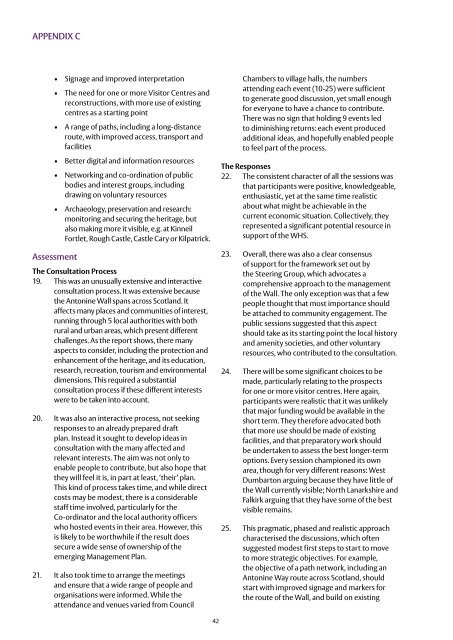The Antonine Wall Management Plan 2013-18 - Glasgow City Council
The Antonine Wall Management Plan 2013-18 - Glasgow City Council
The Antonine Wall Management Plan 2013-18 - Glasgow City Council
You also want an ePaper? Increase the reach of your titles
YUMPU automatically turns print PDFs into web optimized ePapers that Google loves.
appendix c<br />
• Signage and improved interpretation<br />
•<br />
•<br />
•<br />
•<br />
•<br />
Assessment<br />
<strong>The</strong> need for one or more Visitor Centres and<br />
reconstructions, with more use of existing<br />
centres as a starting point<br />
A range of paths, including a long-distance<br />
route, with improved access, transport and<br />
facilities<br />
Better digital and information resources<br />
Networking and co-ordination of public<br />
bodies and interest groups, including<br />
drawing on voluntary resources<br />
Archaeology, preservation and research:<br />
monitoring and securing the heritage, but<br />
also making more it visible, e.g. at Kinneil<br />
Fortlet, Rough Castle, Castle Cary or Kilpatrick.<br />
<strong>The</strong> Consultation Process<br />
19. This was an unusually extensive and interactive<br />
consultation process. It was extensive because<br />
the <strong>Antonine</strong> <strong>Wall</strong> spans across Scotland. It<br />
affects many places and communities of interest,<br />
running through 5 local authorities with both<br />
rural and urban areas, which present different<br />
challenges. As the report shows, there many<br />
aspects to consider, including the protection and<br />
enhancement of the heritage, and its education,<br />
research, recreation, tourism and environmental<br />
dimensions. This required a substantial<br />
consultation process if these different interests<br />
were to be taken into account.<br />
20. It was also an interactive process, not seeking<br />
responses to an already prepared draft<br />
plan. Instead it sought to develop ideas in<br />
consultation with the many affected and<br />
relevant interests. <strong>The</strong> aim was not only to<br />
enable people to contribute, but also hope that<br />
they will feel it is, in part at least, ‘their’ plan.<br />
This kind of process takes time, and while direct<br />
costs may be modest, there is a considerable<br />
staff time involved, particularly for the<br />
Co-ordinator and the local authority officers<br />
who hosted events in their area. However, this<br />
is likely to be worthwhile if the result does<br />
secure a wide sense of ownership of the<br />
emerging <strong>Management</strong> <strong>Plan</strong>.<br />
21. It also took time to arrange the meetings<br />
and ensure that a wide range of people and<br />
organisations were informed. While the<br />
attendance and venues varied from <strong>Council</strong><br />
Chambers to village halls, the numbers<br />
attending each event (10-25) were sufficient<br />
to generate good discussion, yet small enough<br />
for everyone to have a chance to contribute.<br />
<strong>The</strong>re was no sign that holding 9 events led<br />
to diminishing returns: each event produced<br />
additional ideas, and hopefully enabled people<br />
to feel part of the process.<br />
<strong>The</strong> Responses<br />
22. <strong>The</strong> consistent character of all the sessions was<br />
that participants were positive, knowledgeable,<br />
enthusiastic, yet at the same time realistic<br />
about what might be achievable in the<br />
current economic situation. Collectively, they<br />
represented a significant potential resource in<br />
support of the WHS.<br />
23. Overall, there was also a clear consensus<br />
of support for the framework set out by<br />
the Steering Group, which advocates a<br />
comprehensive approach to the management<br />
of the <strong>Wall</strong>. <strong>The</strong> only exception was that a few<br />
people thought that most importance should<br />
be attached to community engagement. <strong>The</strong><br />
public sessions suggested that this aspect<br />
should take as its starting point the local history<br />
and amenity societies, and other voluntary<br />
resources, who contributed to the consultation.<br />
24. <strong>The</strong>re will be some significant choices to be<br />
made, particularly relating to the prospects<br />
for one or more visitor centres. Here again,<br />
participants were realistic that it was unlikely<br />
that major funding would be available in the<br />
short term. <strong>The</strong>y therefore advocated both<br />
that more use should be made of existing<br />
facilities, and that preparatory work should<br />
be undertaken to assess the best longer-term<br />
options. Every session championed its own<br />
area, though for very different reasons: West<br />
Dumbarton arguing because they have little of<br />
the <strong>Wall</strong> currently visible; North Lanarkshire and<br />
Falkirk arguing that they have some of the best<br />
visible remains.<br />
25. This pragmatic, phased and realistic approach<br />
characterised the discussions, which often<br />
suggested modest first steps to start to move<br />
to more strategic objectives. For example,<br />
the objective of a path network, including an<br />
<strong>Antonine</strong> Way route across Scotland, should<br />
start with improved signage and markers for<br />
the route of the <strong>Wall</strong>, and build on existing<br />
42












![Elgin Cathedral Wedding Brochure [pdf, 544kb] - Historic Scotland](https://img.yumpu.com/22301571/1/190x151/elgin-cathedral-wedding-brochure-pdf-544kb-historic-scotland.jpg?quality=85)



